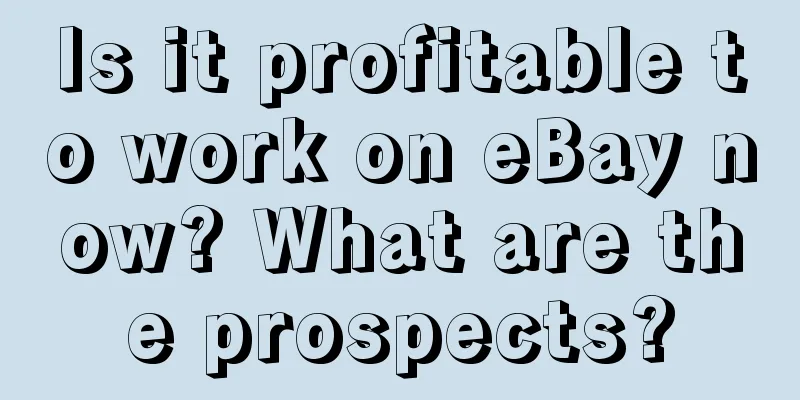[Planting flowers in private domains and planting grass in public domains] Full-link content marketing methods for small and beautiful businesses
![[Planting flowers in private domains and planting grass in public domains] Full-link content marketing methods for small and beautiful businesses](/upload/images/67e762b22b064.webp)
Unlike large-scale businesses, the core path for small and beautiful businesses is to maintain the smallest profitable unit to achieve steady growth and to build the brand and develop the business in the most cost-effective way. Therefore, this article will focus on the methodology of content marketing-driven growth - achieving growth at the lowest cost. 1. Great opportunities for small and beautiful businessesLet’s talk about the current opportunities for small and beautiful businesses from two perspectives: 1. National consumption continues to be fragmented and segmented, especially in terms of aesthetics and experienceThe fashion industry is the most typical example. In recent years, fast fashion brands that focus on design, such as Zara and HM, have lost their popularity and have even continued to close stores in China. Judging from the iteration of demand, the era of "following big brands and buying cheap alternatives" has passed, and personalization has gradually become the mainstream of creative style. "The subdivision of clothing styles has long gone beyond the three categories of business, sports, and leisure. There are at least 20 to 30 styles of clothing keywords for young girls. Girls who like avant-garde trends, French laziness, American retro, Y2K functionality, BM, Japanese sweetness, rural forest girls, chaebol daughters, and new Chinese styles are pushing unique, original, and personalized clothing brands to more people." Personalized and circle-based segmentation means that large-scale fast fashion will gradually be replaced by more specialized and sophisticated "small and beautiful". Of course, in other consumer sectors, as a new generation of consumers grows up, personalization and fragmentation are also major trends. 2. This year's online platform strategy changes have brought more opportunities for small and beautiful companiesThis year, e-commerce platforms continue to compete on "price/performance" , and big brands are required to control prices more strictly: same price, discount, and price reduction. Big brands are facing the double competition of traffic and price on the left hand, and the consumers' price comparison mentality on the right hand, which makes it even more difficult. In contrast, small and beautiful businesses in niche areas are receiving support. They can not only contribute high-quality and low-priced goods, but also provide rich and interesting content and services. Price and stickiness are the focus of competition among major platforms. Taobao has returned to the Internet and to Taobao , and on May 10th, it established the Small and Medium Enterprise Development Center. "We have made it very clear that we will strategically support small and medium-sized businesses more, so that good small and medium-sized businesses can experience very big changes." On Douyin, the basic consensus now is that big brands give money to Douyin, while small brands take advantage of it . For big brands, it is almost impossible to maintain the GMV scale by relying on natural traffic, and paid traffic is visibly getting more and more expensive. Small brands, on the other hand, can more easily obtain some natural traffic by relying on content and algorithms, plus personal IP, and often survive well (without rushing to expand on a large scale). Not to mention Xiaohongshu, which is naturally suitable for starting from scratch and being small and beautiful. Whether it is the aesthetic preferences of community culture, the relatively decentralized ecology and traffic equality ecology of koc, or the latest online sales notes and celebrity buyer store live broadcasts, it provides a friendly growth space for brands from 0 to 1. Although WeChat is slow, its support for video accounts and live streaming is still obvious. This year, many small and beautiful businesses have started well through the combination of video accounts and live streaming + private communities. Therefore, for small and beautiful businesses, there are good opportunities in terms of consumer demand and platform policies. If they take advantage of this favorable trend and combine it with content marketing, they will undoubtedly usher in a golden period of growth. 2. Small but Beautiful: Content Marketing Drives GrowthIf small and beautiful brands want to grow at the lowest cost and establish their own stable and healthy profit model, the fastest and most effective way is content marketing. It can be summarized as a model: [Plant flowers in private domains and plant grass in public domains ] - tell the stories of users (and products) in the public domain, and tell your own (brand) story in the private domain. The former attracts targeted users' attention by attracting precise traffic through content, while the latter carefully polishes the brand story, strengthens conversion and shapes the brand's intrinsic influence. Let me give you an example. This year, a steamed bun shop in Hangzhou became very popular. It is called [Tuntun Steamed Bun Store]. There are long queues in front of the store every day. This shop specializes in [Healthy Chinese Steamed Buns], which are filled with all kinds of novel and unique fillings. How did this store become so popular? The owner spent more than half a year managing her account on social media platforms. A girl born in the 2000s quit her job to make steamed buns. She learned how to make steamed buns, set up a stall, do market research, choose a store, decorate the store, etc. She went from being full of confidence to encountering setbacks and being "educated", and then regaining confidence. After accumulating fans, she opened a store. Later, she began to promote products in the public domain, including visiting stores and checking in, product experience, etc. In the promotion content, she emphasized the fun and boldness of the products and the health and naturalness of the ingredients. To be honest, her steamed buns are not cheap - the price is still controversial, and sometimes the taste and quality control are also challenged. Why are people still willing to buy them? On the one hand, her own story reflects the vision and hope of many young people in starting a business, and people can't help but be more tolerant (actually, more tolerant of themselves); On the other hand, when promoting products in the public domain, she provided value beyond the product itself - social value recognized by young people: the steamed buns were too dry without oil or sugar, but they were more healthy ; various interesting seasonings had the exploration value of opening a blind box; the design of the non-woven coffee cup bag from Starbucks was not only interesting but also in line with the concept of environmental protection ... These are the "internal solutions" provided for young people - healthy, environmentally friendly and interesting life propositions, not just steamed buns. Let’s explain the gameplay in detail below. 1. Public and private domains, building a dual altruistic story systemTo summarize in one sentence: Build a dual altruistic story system, using story prototypes for private and public domains respectively. For small and beautiful brands, they need to attract users in the early stage, and they must use altruistic value as an attribute of exchange. Among all the altruistic values, the one with the lowest cost and the greatest platform dividend is to create content. In telling stories in a small and beautiful way, whether in the public or private domain, the core protagonist should not be the brand (or its manager) in essence, but the target user: the brand becomes a supporting role in the story, while the user becomes the protagonist at an invisible level, satisfying the user's potential needs, rather than focusing only on the self. For example, the girl who makes steamed buns mentioned above, the protagonist of her story is not essentially herself, but a labeled image of "a girl born in the 2000s who quit her job and started a business." These girls are eager to try new things and are full of curiosity. They are also typical user images (projections). However, there are subtle differences between the public domain and the private domain: In the private domain, content is provided based on consumer portraits to meet value; In the public domain, provide solution value based on consumer needs. (1) Private domain cultivation: providing value and establishing projection Yu Xiaoge founded an e-commerce buyer store, Big Eyes Buy Buy, whose private domain is her personal public account (Big Watermelon Baby Mom). What kind of content does she output? Basically, it revolves around work, raising children, family life, and sensitive topics that are of high social concern, such as middle-aged couples, international schools, and confinement nannies, etc., which are all topics that middle-class mothers are keen on. In these stories, she constantly provides fans with similar life situations with topics to participate in, interests to watch, and outlets for expressing similar emotions. More importantly, by sharing and delivering value, we can establish a subtle understanding and resonance with users on the mental dimension. In addition to emotional value, rational value is also the material for building brand stories. For example, the public account of Yu and Mao mainly outputs brand, marketing and industry-related operation methods, which are purely rational content. However, behind these contents is also our own growth and experience, which is also the projection of marketers - we have also grown step by step. Note that if an IP that outputs rational values takes a "purely rational" approach, it will often create a gap and distance with users. There are two ways to establish a closer connection : 1. Use emotional ways to explain things; 2. Add individual growth and experience. In essence, both allow fans to see the real person through the truth. From the perspective of operability, the latter is easier to use. Therefore, there are two key points in telling stories and building brand IP in the private domain:
If you provide emotional and perceptual values, pay attention to establishing a sense of similarity and resonance. If you provide rational values, it is best to establish a growth-oriented projection relationship: People need to be comforted emotionally, and they also need to see the possibility of self-growth in rationality; they need emotional resonance to achieve self-consistency, and they also need encouragement and support to gain guidance. Meeting these two points will not only ensure that content has sufficient appeal and dissemination value, but also allow fans to continue to give trust and tolerance - people are always extremely tolerant of themselves (their projections). In terms of specific directions and topics, it is recommended to focus on the corresponding points of interest of [target audience portrait]. Here are some suggestions on the direction of private domain IP content in typical industries for your reference: If you want to get more advanced methods and rhythm, you can also focus on studying the section "How to Create Brand Content in the Fragmented Era" in the course "Full-Link Brand Marketing Operation Method" by Yuruohemao. (2) Public Domain Promotion (Stories): Solving Problems and Describing Success Public domain seeding is about telling stories around user needs. Every seeding should tell a story about "satisfying needs". In the book "Your Customers Need a Good Story", a story model based on user value is mentioned: A character—encounters a problem—meets a guide—provides him with a set of solutions—calls him to action—ultimately achieves success—helps him avoid failure. To simplify a little more, the model of this story can be summarized as: People-Problem-Solution-Success For example, if your users are middle-class moms and your product is Pilates classes, the story framework is to help busy moms ensure they participate in effective exercise every week so that they feel healthy and full of energy:
When we promote the girlfriend phone, if we follow the conventional practice of digital 3C products, we often hold a press conference, do product evaluation, unboxing, etc. However, in the current communication context, it is difficult to impress the target audience by simply letting the "object" be the protagonist. Therefore, we also adopted the above-mentioned [character-problem-solution-success] story template:
The full story is: the girls use their girlfriends' phones to get up early and check in for AI fitness classes, cook according to recipes, watch TV series on the big screen while eating, sing karaoke with friends in the afternoon, and drag their girlfriends' phones to the bathroom at night to take a bath and watch movies...spending a meaningful and comfortable day. Here, there is a key point worth discussing: what exactly is the user's [problem]: The superficial external problem is often about completing a specific task, while the deeper internal problem is the needs that one desires to achieve. For example, some time ago, I wanted to transport my cat from Beijing to Hangzhou, so I saw a lot of [human-pet transport] agencies, which provide chartered vehicles and professional drivers to transfer small animals from City A to City B. I found that the content of one of the agencies was very interesting. In just a few short sentences, they described the shipping journey from the perspective of the pet: [I am a curious cat, exploring everywhere, discussing how comfortable the special car is], [The fierce cat and the princess litter box are a perfect match], [Awkward puppy: My mom couldn’t wait to pick me up as soon as the college entrance examination was over]... and then add pictures or short videos to show the various comfortable states of the pets in the car. This story template is very clever: the owners' external problems seem to be a turn of events, but deeper down they just want their pets to live a healthy, relaxed and happy life. To summarize, for small and beautiful businesses (which need to attract users themselves, rather than having their own fixed fans and appeal like big brands), the main storyline of [providing value to users and making the brand a supporting role] should be followed: Private domain: Based on user portraits, provide emotional value or rational growth value and establish a projection relationship between each other. Public domain: Build a corresponding story template [character-problem-solution-success] based on the deep needs of users. 2. Leverage traffic to achieve content-driven growthLast year, we discussed the content of global marketing (long article) and everything about marketing, including Douyin, Xiaohongshu, Bilibili, WeChat, Zhihu, and Weibo. Here, we will make a further analysis of small and beautiful businesses: (1) Service platform preference, master the traffic password Small and beautiful means that the cost of content marketing will not be high. It is not a saturation attack through large-scale network coverage, but a way to obtain natural traffic at the lowest cost. The key here is that in addition to providing [user value], you must become a [traffic service provider] suitable for the platform. That is to say, our content, on the one hand, must serve users and provide [solutions-vision of success], and on the other hand, it must also serve the platform's traffic preferences and thus obtain the platform's traffic tilt. For example, some time ago we have been making popular short videos about news, because these videos are close to hot topics, short, fast and timely, which is the content that Douyin likes (can have higher clicks, interactions and completion rates), and we cater to their needs, because each video can get tens of millions of traffic. What kind of content does Xiaohongshu like? Judging from the platform's diversified lifestyle themes, Xiaohongshu likes a combination of emotional and practical content. Emotional content is naturally favorable and participatory to women, while practical content provides search satisfaction and collection value. If the two can be combined, it will undoubtedly gain the platform's traffic code. Therefore, the more emotional and stronger the tone of the title and cover, the better. However, the content should not be all about emotions, but should have substantive value. For example, regarding the content of the female Pilates course mentioned above, the title on Xiaohongshu is - [35+ married with children, everyone expects me to be fat] , which seems to express dissatisfaction (emotion) with family members. When you click on it, you will find that it is talking about: everyone is squeezing out their own lives, making themselves lose shape unknowingly, and then how to use fragmented time to exercise, such as taking Pilates classes, and finally get back in shape. Bilibili likes to combine entertainment and knowledge, and emphasizes sincerity; public accounts prefer in-depth content with strong timeliness, and video accounts are prone to becoming popular because of novel content or opinions that "open people's eyes", and the more original the Moments are, the better... (2) Low-cost hits and investment that breaks the circle In terms of specific operations, for small and beautiful businesses, it is recommended to focus on a public domain platform in the early stage, create an algorithm-favorable [story template], and continuously test (CPC, interaction rate, active search and other indicators) and polish it through KOC cooperation. When encountering the potential for explosive sales, increase traffic investment, use low-cost traffic to promote it in the early stage, and purchase accurate traffic in the later stage to strengthen conversion. Take Douyin and Xiaohongshu as examples: Douyin: KOC cooperation - dou+ heating - content promotion service - Qianchuan or bidding delivery Xiaohongshu: KOC cooperation - video stream - search information stream bidding In terms of specific operations, in the initial stage, you can cooperate through shipping products or pure commissions, and then use traffic tools to expand in the later stage, or you can cooperate with higher-level influencers to break the circle. After a platform has developed for a period of time, the story template can be fine-tuned based on the platform's content consumption habits and replicated on multiple platforms. For example, in the story template of Douyin, "success" is usually placed in front to catch people's attention in the first three seconds. (3) Identify the target and directly convert or introduce private domain There is another key point that needs to be noted. For small and beautiful businesses, is the goal of seeding grass to accumulate private domain or to convert immediately? Of course, we can judge according to different industry types and different content platform strategies, or we can advance in two lines. Instant conversion, just use a trailer or a chain. For some products with low customer price and low decision-making, this can be set up, and the delivery efficiency can be verified in real time. For products with relatively high average order value or high decision-making participation, consider introducing them into the private domain first. How to guide them? There is a method I would like to share with you. According to the story template [Character-Problem-Solution-Success], among these four elements, you can deliberately leave the [Solution] element blank. For example, the specific solution can be obtained by adding it to the private domain, or you can simply leave it blank and wait for users to ask. Note that when leaving blank space, we should deliberately increase the weight of both sides - [Problem] and [Success], highlighting the pain of the problem and the pleasure of success , so that users will receive enough "pressure" from both sides and choose to actively explore solutions. To sum up, small and beautiful content marketing has the following methods and steps in terms of traffic: 1. In terms of user value provision, add platform traffic preference 2. Adopt a small investment + bet on a hit + break the circle again model 3. Focus on one platform in the early stage, replicate to multiple content platforms in the middle and late stages, and make fine adjustments for adaptability 4. It is recommended to set grass-planting goals based on the purchasing habits of different categories. If the goal is to direct to the private domain, remember to leave blank space in [Plan] and take drastic measures in [Problem] and [Success]. Author: Lan Lan WeChat public account: Taro and Cat Talk (ID: taro_cat) |
<<: The same product has different prices, why is it still selling well?
>>: Xiaohongshu’s maternal and infant insights: What content are brands paying for?
Recommend
Getting Marketing Done: User Interaction Bus
A good activity not only needs to have attractive ...
Even if Cook comes, we have to buy goods. Huaqiangbei's "new specialty" is popular on Xiaohongshu
This article delves into how Huaqiangbei’s innovat...
Taobao launches "WeChat Pay", is China's Internet beginning to fight against involution?
With Taobao announcing that it will support WeChat...
B station "horizontally"
Bilibili changes the playback volume indicator, an...
It’s not Pinduoduo that defeats Alibaba!
Pinduoduo's market value surpassed Alibaba? Wh...
Young people on Xiaohongshu have fallen in love with the "leftovers blind box". Are they really getting the best deal?
On Xiaohongshu, "leftover blind boxes" h...
How to buy things on Shopee? How to open a store on Shopee?
Shopee is one of the e-commerce platforms that has...
Ozon launches new payment method Lianlian cross-border wallet
Ozon announced the launch of a new payment method ...
Who is the most influential short play creator? Xinbang officially released the "Short Play Creator Influence List"
With the rapid development of short video platform...
Can I use Apple ID to pay for eBay? What should I pay attention to?
More and more people like to shop online. When cho...
How can Chinese brands take root in the Japanese market? A conversation with Xidao Consulting, ROMOSS, and Hesheng
As Japanese consumers' awareness of Chinese br...
The 10-yuan "magic tool for making photos" is all bought by young girls. The boss said: I'm afraid of running out of stock
The triangle scarf is rapidly becoming a new favor...
How to fill in the return address on Shopee? What are the rules?
Nowadays, many people like to buy imported goods, ...
Why are movie tickets in county towns more expensive than in Beijing, Shanghai and Guangzhou?
In some county towns, movie ticket prices even exc...
The marketing calendar is here, no need to worry about marketing inspiration in May!
May is approaching, and the weather is getting war...









